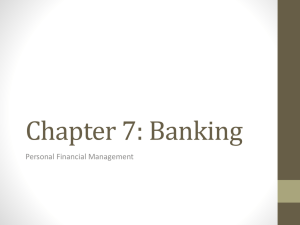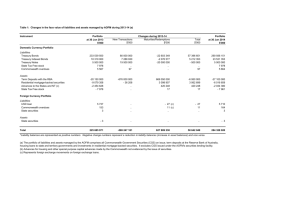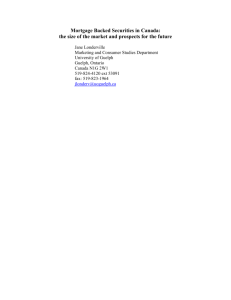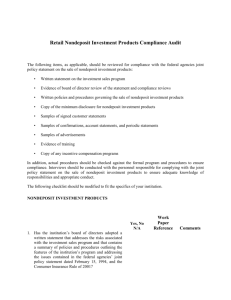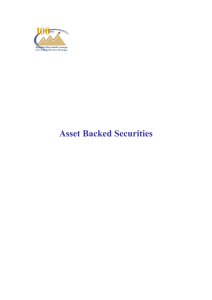12551,"financial disintermediation",5,6,"2000-11-20 00:00:00",50,http://www.123helpme.com/financial-disintermediation-view.asp?id=165045,3.4,176000,"2015-12-25 17:13:40"
advertisement
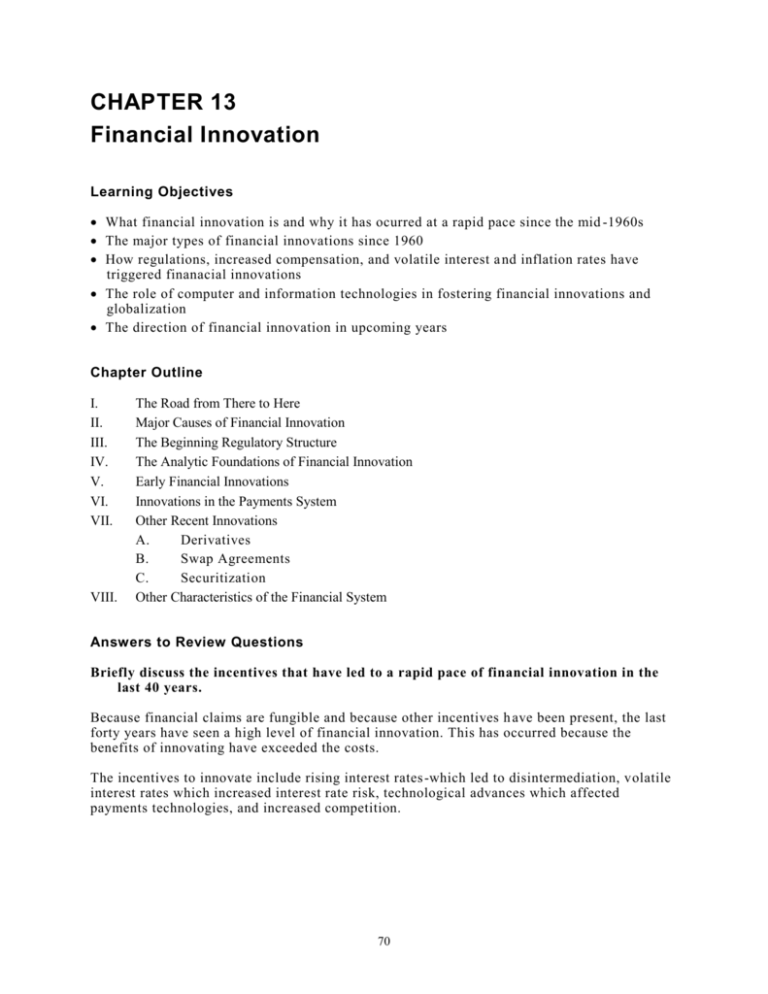
CHAPTER 13 Financial Innovation Learning Objectives What financial innovation is and why it has ocurred at a rapid pace since the mid -1960s The major types of financial innovations since 1960 How regulations, increased compensation, and volatile interest a nd inflation rates have triggered finanacial innovations The role of computer and information technologies in fostering financial innovations and globalization The direction of financial innovation in upcoming years Chapter Outline I. II. III. IV. V. VI. VII. VIII. The Road from There to Here Major Causes of Financial Innovation The Beginning Regulatory Structure The Analytic Foundations of Financial Innovation Early Financial Innovations Innovations in the Payments System Other Recent Innovations A. Derivatives B. Swap Agreements C. Securitization Other Characteristics of the Financial System Answers to Review Questions Briefly discuss the incentives that have led to a rapid pace of financial innovation in the last 40 years. Because financial claims are fungible and because other incentives h ave been present, the last forty years have seen a high level of financial innovation. This has occurred because the benefits of innovating have exceeded the costs. The incentives to innovate include rising interest rates -which led to disintermediation, volatile interest rates which increased interest rate risk, technological advances which affected payments technologies, and increased competition. 70 Financial Innovation 71 What is disintermediation? When is disintermediation likely to occur? What factors can reduce it? If I take my funds out of my credit union and put them in a money market mutual fund, have I disintermediated? Why or why not? Disintermediation is the removal of funds from a financial intermediary. Disintermediation is likely to occur when direct lending in a financial market offers a higher rate of return. Removing regulations, especially Regulation Q, can help reduce disintermediation because the intermediary is able to offer higher rates to compete with open market instrument when interest rates rise. If I take my funds out of my credit union and put them in a money market mutual fund, I have not disintermediated because my funds are still deposited in a financial intermediary, the money market mutual fund. Discuss the roles that technology and regulation play in aiding financial innovation. Will innovation always occur to exploit loopholes in regulations? Financial innovation is the adoption of new technologies and products to increase profitability. In recent years, technological advances in telecommun ication and computer technologies have led to many innovations that have reduced the cost of making payments and transferring funds. Information technologies have also fostered the creation of new financial products and the globalization of finance. Innovation will occur to find loopholes in regulations whenever the regulations are binding — that is, whenever the regulations force the intermediary into behavior that it would not otherwise adopt and hence causes it to earn less profit. The pace of innovat ion accelerates whenever the benefits increase. For example, when interest rates rise, the benefits of finding ways around Regulation Q interest rate ceilings increased. Also, when interest rate and exchange rate volatility increased, the benefits to fin ding innovations that hedged interest rate and exchange rate risk increased. What are nondeposit liabilities? Give some examples. What are negotiable CDs? How do nondeposit liabilities differ from negotiable CDs? What are retail sweep accounts? Nondeposit liabilities are borrowed funds, such as Eurodollar borrowings, fed funds, and repurchase agreements, which are not deposits and not subject to reserve requirements or Regulation Q ceilings. Nondeposit liabilities often result from the re -labeling of deposit liabilities to nondeposit liabilities to get around regulations that pertain to deposits. Negotiable CDs are large certificates of deposit, which have a secondary market. Unlike nondeposit liabilities, negotiable CDs do not entail the re -labeling of deposit liabilities because negotiable CDs are deposit liabilities. A more recent innovation, retail sweep accounts are the re -labeling of deposit liabilities to nondeposit liabilities. First appearing in 1994, they “sweep” balances out of transaction s accounts that are subject to reserve requirements and into other deposits (usually money market deposit accounts) that are not. Required reserves fall by the amount of funds in sweep accounts multiplied by the required reserve ratio. As required reserve s fall, ceteris paribus, banks have more funds to lend. 72 Chapter 13 What is Regulation Q? Regulation D? Discuss ways banks have found to get around both regulations. Regulation Q set interest rate ceilings on deposits at commercial banks. Regulation Q was enacted during the Great Depressions in the 1930s and was phased out in the early 1980s. Regulation D prescribed reserve requirements on deposits at commercial banks. Banks found innovations to get around both regulations. For example, nondeposit liabilities s uch as fed funds, repurchase agreements, and Eurodollar borrowings re -labeled deposit liabilities to nondeposit liabilities and got around both regulations. Negotiable CDs are another innovation that got around interest rate ceilings and reserve requireme nts. What is securitization? How does securitization reduce interest rate risk? Name some types of liabilities that are now securitized. Securitization is the process whereby relatively illiquid financial assets such as mortgages are packaged together and sold off to individual investors. Securitization turns relatively illiquid instruments into quite liquid investments called asset -backed securities. A market maker agrees to create a secondary market by buying and selling the securities. Securitization ori ginated in the mortgage market in the early 1980s, when mortgage loans began to be packaged together and sold off as securities in the secondary market often with government insurance guaranteeing that the principal and interest would be repaid. Securitiza tion became popular because it provides a way of protecting against interest rate risk in an environment of increased interest rate volatility. Securitization offers reduced credit risk because of the pooling of assets. Since the mid-1980s, securitization has spread from the mortgage market to other markets including credit card balances, automobile and truck loans and leases, accounts receivable, computer leases, home equity loans, student loans, railroad car leases, small business loans, and boat loans. Banks, finance companies, retailers, thrifts, and others issue asset -backed securities that provide them with new funds to lend. Securitization, which is a form of direct finance, has experienced phenomenal growth since the early 1990s and may replace much of the lending that historically has gone through traditional intermediaries (indirect finance). Discuss some characteristics of the financial system of the early 2000s that make it different from earlier periods. There are many differences in the financial system in the early 2000s than in recent decades. First, deregulation had made the financial system much less regulated. Also, the financial sector is becoming more competitive because (1) geographic barriers for financial services are disappearing; (2) FIs are becoming less specialized; (3) interest rate ceilings and usury laws have been abolished; (4) securitization is spreading to many markets; (5) financial futures and options are increasingly being used to hedge risk; (6) financial transacti ons are becoming increasingly automated; and (7) banks are expanding into other areas, such as data processing, leasing, etc. In addition, the financial system has become globalized because of technological advances in the transfer of funds. How have increased competition and price volatility affected financial innovation? What are some specific types of innovation that deal with these factors? Financial Innovation 73 Increased competition and price volatility are two of the primary factors that have fostered financial innovation in recent decades. Because banks have faced increased competition from other financial intermediaries and other nonfinancial institutions, they have innovated into new product areas in order to meet and “beat” the increased competition. For example, banks have developed new sources of income such as fee income and new product lines because of increased competition. Also, the development of nondeposit liabilities allows banks to maintain lending even if they lose deposits to their competition throug h disintermediation. Technological advances and new assets have been and are being developed to mitigate greater competition and price volatility. How do collateralized mortgage securities differ from mortgagebacked securities? Which has less risk? Mortgage-backed securities result from the process of securitization of mortgages when market makers package mortgage loans and sell them to individual investors in the secondary market. Although mortgage-backed securities sometimes carry government guaran tees, there are still several risk involved including credit risk, interest rate risk, and prepayment risk. Prepayment risk is the risk that the mortgages will be paid off or refinanced early when interest rates fall and the proceeds to the lender will h ave to be reinvested at a lower interest rate. Collateralized mortgage securities may reduce this risk by redirecting the cash flows of mortgage related instruments to various classes of bondholders. Collateralization allows a risk averse investor to choose an instrument with an early repayment of principal. For this reason, collateralized mortgage securities can offer less risk as compared to mortgage -backed securities Defend the following statement. Once an innovation appears, it will remain even aft er the impetus for its development disappears. Give an example. As long as there is profit to be gained by utilizing a particular innovation, the innovation will remain, even after the impetus for its development disappears. An example is money market mutual funds. The initial impetus was to create a vehicle for small investors to get around Regulation Q ceilings. Money market mutual funds did not disappear even after Regulation Q ceilings were removed. Discuss how banks can reduce their reserve require ments. Banks can reduce their reserve requirements by encouraging their customers to transfer funds from deposit accounts subject to reserve requirements into accounts that are not. Examples of such accounts would be eurodollar deposits, negotiable CDs, a nd retail sweep accounts. Are financial claims more fungible today than in the past? Why? Financial claims are more fungible today than in the past because of technological advances in computer and information technologies. Funds are more easily conv erted into other financial instruments and transferred globally than in the past. Why didn’t banks innovate to get around regulations in the 1940s and 1950s? There are several reasons why banks didn't innovate to get around regulations in the 1940s and 1950s. First, many of the regulations such as Regulation Q were not constraining in the 1940s and 1950s. The Regulation Q ceiling rates were lower than open market rates. Second, financial markets were more segmented and banks did not face as much competit ion from other financial and nonfinancial institutions as after 1960. Also, during the 1960s, prices, inflation, 74 Chapter 13 interest rates, and exchange rates became more volatile than before, that made innovations to deal with volatility more profitable. Financiall y, computer and information technologies led to cost saving innovations and the proliferation of new financial instruments. Explain why asset-backed securities are an example of direct finance. If a bank issues asset-backed securities, how does it get new funds to lend? The asset-backed securities market is one where lenders (SSUs) lend their funds directly to borrowers (DSUs). Thus, the process of securitization that gives rise to the asset -backed securities market is an example of direct finance. When a bank issues an asset-backed security, the purchaser does not have a claim on the bank, but rather the pool of assets that back the security. When a bank issues an asset-backed security, it obtains fresh funds that are available for new loans. Answers to Analytical Questions Treasury STRIPS are a type of government security that allows investors to register and trade ownership of the interest (coupon) payments and the principal amount of the security. The coupon and principal payments can each be sold separately at a discount. What risk is this innovation effectively allowing the investor to unbundle? Treasury STRIPS offer the advantage that each coupon payment and the principal amount associated with the security may be sold separately at a discount to investors. The investor’s gain is the difference between today’s (discounted) price of either the coupon payment or the principal and the future payment received upon maturation of the STRIP. This mitigates the risk arising from the uncertainty associated with the future direction of interest rates. In other words, STRIPS protect the investor from losses associated with reinvesting the coupon payments at a lower interest rate because interest rates may have fallen since the security was issued. With Treasury STRIPS, there are no coupon payments thus avoiding the possibility that such payments may have to be reinvested at a lower interest rate. Explain the process by which a group of credit card balances could be securitized. Securitization is the process whereby relatively illiquid financial assets (such as credit card balances) are packaged together and sold off as securities to individual investors. Securitization turns relatively illiquid instruments into quite liquid investments called asset backed securities. A market maker agrees to create a secondary market by buying and selling the securities backed by the credit card balances. Securitization became popular because it provides a way of protecting against interest rate risk in an environment of increased interest rate volatility. Securitization spread from the mortgage market to other markets including credit card balances. Assume a reserve requirement of 10 percent. If Chemical Bank is successful in getting Microsoft to convert a $2 million demand deposit to a Eurodollar deposit, how much can Chemical Bank lend out because of this transaction? Chemical Bank is required to hold reserve assets equal to 10 percent of the $2 million demand deposit liability. There are no reserve requirements on e urodollar deposits. Therefore, when Financial Innovation Microsoft converts its $2 million demand deposit at Chemical Bank to a eurodollar deposit excess reserves increase by $200,000. Chemical Bank can sa fely lend all excess reserves. 75

